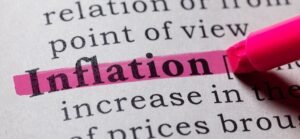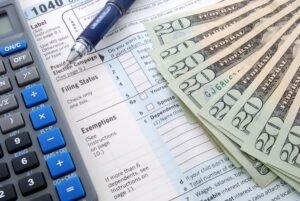What is Inflation and How to Prepare for It

Table of Contents
The headlines have boldly pronounced that inflation in the United States is back after a long hiatus. All indications are that inflation is bad, has a nefarious source, and hurts the average consumer.
But is all this true? What is inflation? How can a retail investor protect their portfolio from the gnarly impacts of inflation? In this article, I will answer these questions and explain while inflation should be monitored, the worry and finger pointing is likely overblown.
The Definition of Inflation
 Inflation is very simple when you ignore politics, geopolitical conflicts, and supply / demand issues. Inflation is the reduction in purchasing power of money. How or what causes it is likely something you have no control over.
Inflation is very simple when you ignore politics, geopolitical conflicts, and supply / demand issues. Inflation is the reduction in purchasing power of money. How or what causes it is likely something you have no control over.
Another way to think about inflation is as, ‘too many dollars chasing too few goods.’ This statement reflects the effect a large money supply in an economy can have on prices. It’s much like a grass roots organization of individuals slowly bidding up prices for common goods.
An inflation rate of 3% means that goods and services cost 3% more than they did a year prior. If a turkey at Christmas cost $10.00 in the first year, then it would cost $10.30 the following year.
Often the effects of inflation are noticed over a long period… but this is not always true.
When inflation is over 50% per year, this is known as hyperinflation. Hyperinflation can be extremely destabilizing for economies threatening the social fabric of entire nations. Prices can escalate rapidly, even within a single day.
In 2008, Zimbabwe experienced inflation at a rate of 79,600,000,000%. According to economicshelp.com, that is almost 100% per day. Prices were literally doubling every single day. The ability to even afford things such as food came into question for much of the populace. Fortunately, things have improved in Zimbabwe since those difficult years.
In the United States, policy makers have set targets for optimal inflation to be around 2%.
Inflation as a Tax
 Understanding inflation to tax a population is aided by thinking about a borrower / lender relationship under positive inflation.
Understanding inflation to tax a population is aided by thinking about a borrower / lender relationship under positive inflation.
As inflation rises, the value of debt goes down. If you owed $10.00 one year but inflation is 5%, then the buying power of that same $10.00 is less than when it started. As a lender, perhaps the $10.00 could have been used to buy 4 gallons of gas in year 1 but only 3.5 gallons in year 2.
Understanding that inflation can be beneficial for the borrower directly translates to the effect inflation has on sovereign debt.
At the time of writing, the U.S. National Debt was close to $30 Trillion. Inflation is at about 5.6%. That means that $30 Trillion is worth about 5.6% less than the prior year… or about $1.58 Trillion! According to the Federal Government, the U.S. collected almost $4.05 Trillion in taxes directly.
This means that the U.S. was able to affect its debt and income position by almost 40% via inflation.
Inflation as a measure of Efficiency
Another way to think about inflation is to consider it a measure of how efficiently supply and demand meet each other’s needs. Previously, the analogy that inflation is too many dollars after too few goods was used. If the balance between money supply and goods available can neutralize quickly, then inflation can be tamped down.
A great example of this is the great Toilet Paper crisis of 2020. As the pandemic reached critical mass, many folks around the world sought comfort in their preferred form of toiletry wipes. The supply quickly ran out.
What wasn’t clear at the time was that Toilet Paper requires a significant amount of space to store. Thus, only a limited amount is available at any one point. If there is a large increase in demand, the ability of manufacturers to keep pace is limited. They are already producing at maximum capacity.
Thus, the toilet paper situation was highly inefficient. If price gouging laws didn’t exist, merchants could have charged more and more for toilet paper as the supply dwindled. This would have been inflationary in nature.
The inflation that would have been caused would have been a result of the inefficiencies in storing toilet paper and expanding manufacturing capacity quickly.
Inflation as a measure of Innovation
Like efficiency, understanding inflation as an indicator or measure of innovation is important too.
If we think back to our Toilet Paper example, manufacturing such a product by hand would be expensive. The amount of supply that could be manufactured at a reasonable price would be limited. The chances that small supply shocks would affect the price in an inflationary way would be high.
But thankfully the manufacture of this precious resource has been outsourced to the machines!
Creating a standard roll of toilet paper has very little human involvement. Innovations over time have helped the industry increase the supply much more easily than if machines weren’t involved. Automation and machination have had a deflationary impact on the prices of toilet paper.
What is Deflation?
Deflation is just the inverse of inflation. It is too few dollars chasing too many goods. The result of this is that prices go down over time due to an oversupply of goods and services.
Deflation can spiral out of control just likes its counterpart. If you were going to buy a TV today but knew that due to deflation or an increase in supply that it would cost less tomorrow, would you wait? What if that was true each day? What if everyone else kept waiting?
Deflation can harm suppliers, manufacturers, and providers of goods and services. Generally, deflation is not desirable in a healthy economy.
Is Inflation Necessary?
Whether inflation is necessary or not may be the wrong question, but perhaps another way to phrase the same intuitive line of reasoning is, why is inflation desirable?
According to an article at the balance, there are two main reasons why a small amount of inflation is considered good:
- It removes the risk of deflation. As I mentioned above, deflation can result in pressure on the supply side of the equation. The downward spiral can result in lower prices and ultimately the failure of businesses.
- It keeps consumers’ expectations that buying now is a good thing. If prices are expected to be more tomorrow, consumers won’t delay because of a perception of a possible better deal in the future.
The Federal Reserve, which I will talk about next, plays a large role when it comes to managing inflation. It’s their job (in the United States) to make sure that the economy chugs away at the optimal level… not too hot and not too cold.
The Federal Reserve and Inflation

The Federal Reserve, also known simply as the ‘Fed’, in the United States has been charged by Congress to keep prices at a stable level. The Fed has determined that an optimal amount of inflation is about 2%. They measure this through monitoring something called the Price Index for Personal Consumption.
So how does the Fed manage inflation? By controlling interest rates of course!
I won’t go into a high level of detail, but by controlling how much the short-term interest rate is that large banks can borrow at the Fed can roughly manage inflation.
By raising rates, the Fed can slow down economic activity by making it more expensive to borrow. By lowering rates, they can make it cheaper to borrow and further light the furnace that keeps the economic engine going.
By closely monitoring inflation and interest rates the Fed can attempt to mold the economy in the way Congress has envisioned. Although they are not always successful, they are by far the most powerful institution that can change such market dynamics at a moment’s notice.
Should You Do Anything About Inflation?
Yes and no. Basically, if you are sitting on a pile of cash, then your money will be losing value as long as inflation exists in any form… whether that’s at the Fed’s 2% target or at the more recent highs of 5% or 6%.
But if you hold equities and bonds you have to ask yourself if inflation targets are already baked into the current price. Do you somehow know something that others don’t know? If you don’t… and I’m guessing that you most certainly do not… then doing nothing maybe the best course action.
If you decide to change your investment composition based on inflation and you are wrong, you risk the chance of missing out on returns. The alternative is also true.
If you are invested in a diversified basket of stocks and bonds matched to your time horizon then making any changes based on specific inflation targets may be a fool’s errand.
What Methods Protect Against Inflation?
As I mentioned above, you may have some dry powder… some cash… sitting on the sidelines you wish to protect against the loss of purchasing power. You can do this in a couple of ways (theoretically).
I wrote another article that just cuts to the chase entitled ‘Protect Yourself from Inflation.’
In that article I covered 6 things you can buy that act as inflationary hedges. In other words, usually the prices of these things are not very well correlated with inflation.
- Gold
- Cryptocurrencies (Bitcoin)
- Real Estate
- Treasury Inflation-Protected Securities (TIPS)
- Fine Art
These are often what you will be recommended if you are specifically looking to protect yourself from a devaluing dollar… I don’t necessarily endorse them (I spell out why for each one in the article).
Summary
In parting, Inflation is a necessary evil that needs to be closely monitored by large government institutions and individual investors alike. Individuals need to plan ahead of time to make sure that their portfolios will succeed once inflation is taken into account.
From day to day, month to month, however you should not be thinking about inflation. Your overall portfolio construction should be diversified… if it is, then you don’t have a lot to worry about.
All that said, if you do want to take a certain amount and specifically earmark it as a hedge, then there are ways to do it. Some of them are poorly understood or highly illiquid… but it is possible. I hope you enjoyed this article! If you have any thoughts on the matter, be sure to throw them in the comments section down below!
Do Your Own Research
I have expressed a number of opinions in this article, but you should always do your own research. Nothing here should be considered advice. Financial advisors, accountants and other professionals should be consulted prior to making important financial decisions with your money.
Guy Money
As a formally trained Data Scientist I find excitement in writing about Personal Finance and how to view it through a lens filtered by data. I am excited about helping others build financial moats while at the same time helping to make the world a more livable and friendly place.



